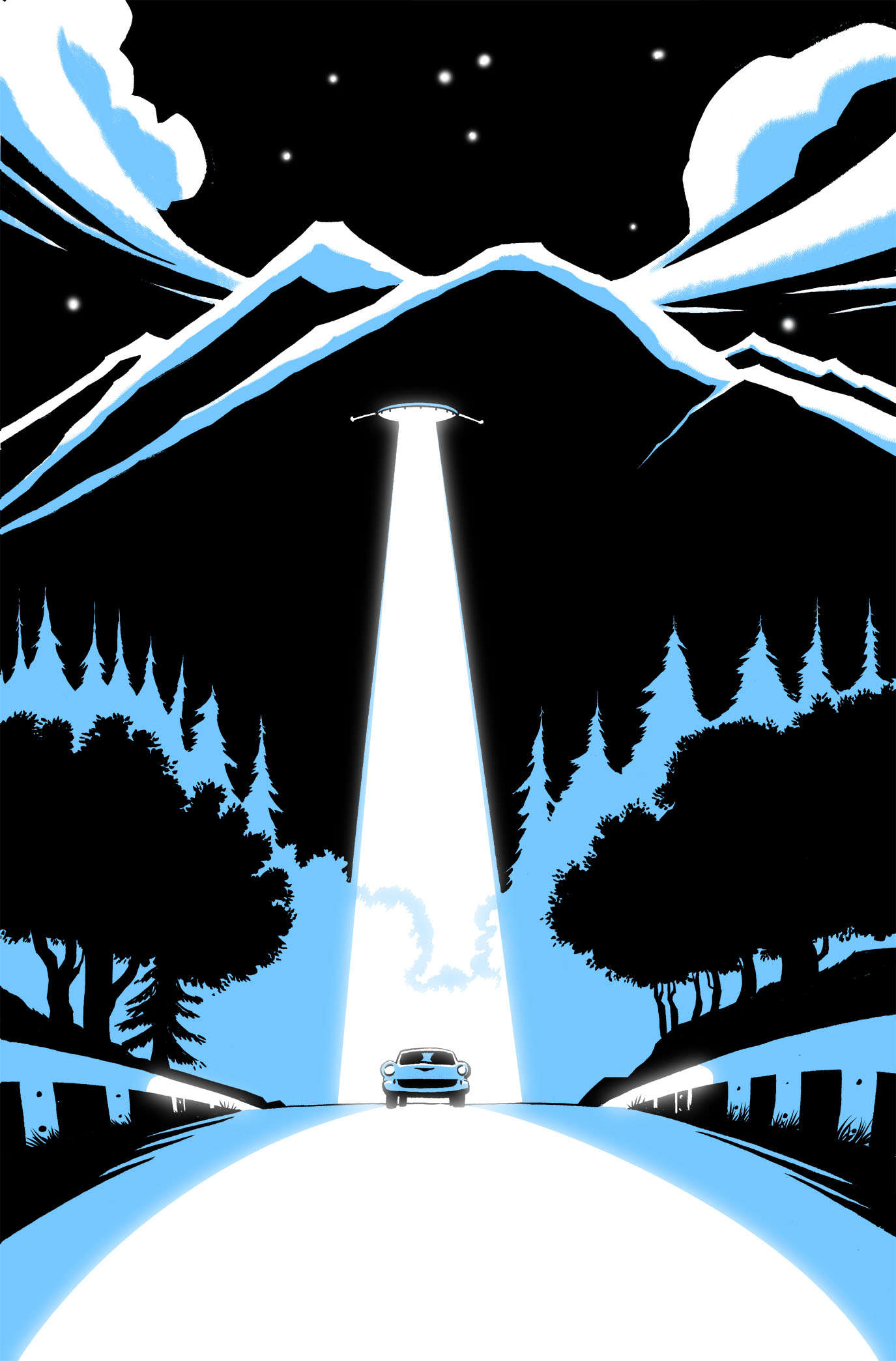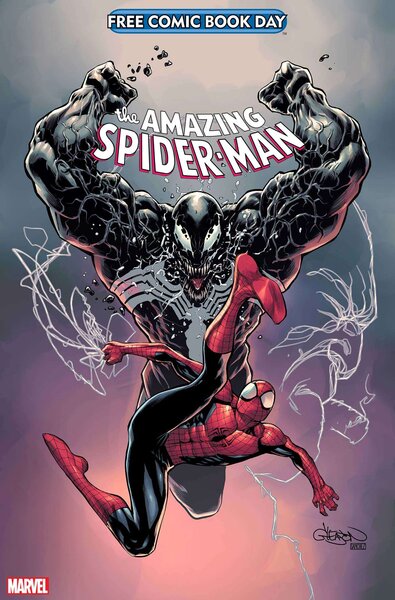Create a free profile to get unlimited access to exclusive videos, sweepstakes, and more!
Comics Wire: Making sense of Substack's creator-owned bet; Free Comic Book Day; Batman '89; and more!

Welcome to Comics Wire, SYFY WIRE's weekly comics column that gets at the pulse of what's going on in comics right now. We've got what you need to know about huge crossovers, real-life issues facing the industry, cool first looks, the week's hot new comics, and everything in-between.
We're living in an interesting time for comics, a time of growth not just upward but outward. Sales are up, and so are the dollars pouring into crowdfunding campaigns on sites like Kickstarter, but it's not just the same old stuff that's selling. The superhero books are still drawing readers, of course, but so are the big ambitious genre comics, the young reader books, the manga that's more accessible to Western readers than it's ever been before. It all speaks to an appetite for more comics, and more delivery systems for those comics. In that spirit, this week Substack threw its hat into the ring in a big way, signaling another major shift in the digital comics market in the coming months and years.
The popular newsletter company revealed Monday that it's entered several new agreements with some of the biggest names in comics as part of a "betting on comics creators" initiative designed to capitalize on Substack's resources and ability to put content directly into the inboxes of as many readers as possible. With that announcement came the news that Batman writer James Tynion IV will be leaving that book, as well his other major superhero title Joker, at the end of the year to focus on more creator-owned projects through a Substack imprint of his company, Tiny Onion, beginning with the Michael Avon Oeming UFO collaboration Blue Book.
Though Tynion's announcement was perhaps the most eye-catching because "The writer of Batman is leaving DC Comics to go write for a newsletter company" is headline-grabbing, it was far from the only big news. Spider-Man: Miles Morales and Abbott writer Saladin Ahmed also announced a creator-owned imprint at Substack, dubbed Copper Bottle, where he and his collaborators will launch new titles including the just-announced Terrorwar, written by Ahmed with art by Dave Acosta.
The Witch Boy author Molly Knox Ostertag also announced a newsletter, which will begin with various thoughts on the comics creating process but will ultimately grow to include a serialized graphic novel, and Nocterra writer Scott Snyder -- who just entered a game-changing creator-owned agreement of his own through ComiXology -- announced that his imprint, Best Jackett Press, will launch a subscription comics writing class through Substack, with virtual courses beginning at $7 per month.
And then there's Jonathan Hickman, who's nothing if not perpetually ambitious. Hickman, who for the last two years has been helming the X-Men line at Marvel, used the Substack announcement to launch Three Worlds. Three Moons, a "concept universe" in which he and collaborators Mike Del Mundo, Mike Huddleston, Al Ewing, Ram V, Tini Howard and more will launch a series of stories of varying lengths and subgenres, all building on the same shared world. You can check out some of the promo art for these concepts in the gallery above, but suffice it to say, it's a lot, and it's a lot coming from some of the biggest names in the game right now.
But this isn't simply a case of a group of creators deciding they'd like to use a subscription-based service to launch new comics, and going with Substack because it's a big name. This is an investment on the part of Substack as well, as cofounder Hamish McKenize outlined in a post accompanying the announcement.
"These creators are supported by Substack Pro packages designed to kickstart going independent and remove the risks of starting a publishing enterprise. We do that by providing a financial guarantee combined with access to services, support, and community. These packages include upfront grants, design and editing services of the creators’ choosing that Substack subsidizes, and monthly stipends to help out with the costs of health insurance.
"The freedom and independence that the deals offer are lasting. The grants give these creators the best possible runway to build their own audiences. At the end of the Pro program, creators are free to leave and take those audiences with them if they want to (it’s up to us to build an ecosystem good enough that they won’t)."
Obviously, creators moving from work-for-hire projects to creator-owned endeavors is nothing new, and obviously this isn't the first time we've seen a wave of top tier talent make that move en masse. Image Comics did it in the early 1990s, and they and other publishers have managed to pull it off in waves of varying sizes ever since, so in some ways we can look at this Substack migration (which, it's worth noting, actually began in some ways with writer Nick Spencer last year) as the next phase of one of those waves, in the spirit but via a different delivery system. Whether this becomes a sea change on the same level as what the Image founders managed is a matter for history, not for the present moment. For now, it's simply clear that these creators -- all of whom have built their reputations in their own ways leading up to this moment -- felt encouraged by what Substack had to offer, and feel empowered to tell stories there.
Of course, this leaves some questions. What does it mean for the direct market, and physical comics in general, that these creators are moving to subscription digital newsletters to sell their stuff? Maybe nothing. These creators own the rights to their stories, so they could release print collections eventually, but even if they don't, doing this doesn't mean they'll stop releasing comics in other avenues. It's not necessarily a replacement for what's there, but rather a different delivery system altogether in the right hands.
What does this mean for the future of comics publishers if consumers are encouraged more and more to give their dollars directly to creators? Well, as we've already mentioned, this isn't the first time a publisher has served as the delivery system rather than part of the creative engine, but there's more to it than that. Look at Kickstarter, and the vast sums of money consumers have dished out there in the last couple of years alone to get their hands on comics they wanted to read. This is, in some ways, like Kickstarter in smaller doses, paying a creator directly to get a product sent right to you.
But of course, central to all of this is the larger, more existential question: Will it work? It seems to be so far, as creators like Tynion are already talking about subscriber numbers far in excess of their expectations, and each of these creators has a built-in audience that they're bringing with them to the platform. Sustaining it might be another matter, but if we're thinking in economic terms, this is also about more than just getting subscribers in the door.
Whether we're talking about The Avengers, The Boys, or The Walking Dead, we live in a world where film and TV studios, producers, agents, and beyond are always on the lookout for the next red-hot idea that they can adapt. The more creators maintain control of those ideas, the more of a say they have in their creative and financial futures with those ideas. It's not just an investment in current creative freedom, but in broader creative legacy, and it feels like something that, for the right creators, could pay off in a big way. Whether you subscribe to these newsletters or not, keep an eye on comics at Substack. It's going to be fascinating to see what comes next.
Free Comic Book Day Returns
Now that we've spent some time talking about the possible future of comics in the digital space, it's time for a reminder to support your local comics shop! After a year of turmoil that meant the annual event was split up in 2020 and was postponed in 2021, Free Comic Book Day is back this Saturday with a full slate of new titles from big and small publishers, all designed to get you into your local shop to take advantage of their sales and walk out with a few things you maybe didn't plan on buying but will still be happy to have.
So, what can you expect from FCBD this year? Well, a rundown of the major titles (minus DC Comics', which are on their blog) is available at the event website, but here are a few highlights:
- A pair of Marvel titles for the event will offer fans a preview of what's to come in the new Hulk book from writer Donny Cates and artist Ryan Ottley and the upcoming Venom run from writers Al Ewing and Ram V and artist Bryan Hitch.
- In addition to a lineup of young reader titles, DC Comics will preview the upcoming Batman: Fear State event and give us a new original story starring The Suicide Squad's favorite adorable shark man, King Shark.
- Dynamite will celebrate the much-anticipated third season of The Boys with a reprint of the first chapter of Herogasm by Garth Ennis and Darick Robertson.
- BOOM! Studios will preview its upcoming Something Is Killing the Children spinoff series with an Enter the House of Slaughter issue from writer James Tynion IV and artist Werther Dell'Edera.
There is, of course, much, much more that this Free Comic Book Day has to offer, so if you're feeling safe, mask up and head to your local shop this Saturday to see what they've got for you. And while you're there, pick up something new.
More news: Blacula rises, Miskatonic is back, and more!
- Horror fans, be on the lookout, because Blacula is about to return in comics form. Writer Rodney Barnes and his Killadelphia co-creator Jason Shawn Alexander announced late last week that they're releasing a new graphic novel adaptation of the classic Blacula cult film that will expand on the original movie while "building a bridge" to the present day. The book is expected to arrive in February, 2022 through Barnes' Zombie Love Studios publishing imprint.
- Over at AfterShock Comics this week, the publisher announced that Lovecraftian period horror series Miskatonic will return this November for a 48 page "One Shock" titled Miskatonic: Even Death May Die, from original creators Mark Sable and Giorgio Pontrelli. I loved the ambition of the original series, and now it seems the creative team's plans are growing bigger...literally. For more information on what's in store, head over to AfterShock's website.
- And finally this week, it's worth noting that Fan Expo has purchased the rights to six of the biggest Wizard World fan convention events in the United States, making the company the largest purveyor of conventions in the market. What this means for the convention landscape as it eventually gets rolling again remains to be seen, but however Fan Expo's ownership shakes out, watching Wizard World fade out feels like the end of an era for a lot of fans.
New comics this week: Batman '89, Defenders, and more!
That's the news. Now let's talk about some of the comics I got excited about this week.
Batman '89 #1: It was always going to be a matter of time before we got a comic sequelizing Tim Burton's Batman, and it was also always going to be a comic I was naturally primed to enjoy as someone of the generation who was first exposed to the Dark Knight on that particular pop culture wave. With that in mind, I definitely enjoyed Batman '89 #1 from writer Sam Hamm and artist Joe Quinones, but perhaps not in the way a lot of people are expecting to enjoy it.
It's easy to imagine a world in which this comic is a nice, predictable piece of connective tissue between Batman and Batman Returns, dancing between the raindrops of those two films while never once attempting to stray from the path set out by Burton's particular storytelling aesthetic, and that comic probably would've been pretty fun to read. What takes this version of Batman '89 out of the realm of fun and into the realm of a flat-out blast are the many ways in which Hamm and Quinones dare to think bigger. There are a lot of plot avenues left open by the end of that first film, and the creative team here seems determined not just to run down them, but to kick open doors and create entirely new ones. Whether we're talking about Harvey Dent's romantic life, the surprising legacy of the Joker, or potential new sidekicks for the Caped Crusader, this is more than a tribute. It's a bold reimagining and a killer exercise in worldbuilding on Hamm's part, bolstered by Quinones' pitch perfect art. If you ever loved these films, you owe it to yourself to dive into this version of what happens next.
Defenders #1: Al Ewing is one of those writers who always seems capable of marrying an incredible sense of reverence and knowledge for the Marvel Universe with a kind of gleeful mischief, twisting classic characters and worlds into situations which challenge everything we know about them without ever losing sight of who they've always been. It's what made his Ultimates run so great, and why his Immortal Hulk is one of the best superhero comics of the last five years.
Defenders, written by Ewing with art by Javier Rodriguez, is another triumph in the same vein, something that feels both familiar and startlingly new all at once, echoing the triumphs of Steve Ditko and Steve Englehart while also feeling unmistakably like a book by Al Ewing and Javier Rodriguez. Rodriguez's art is among the most stunning work you're likely to find in a Big Two superhero title this year, dripping with the strangeness of Ditko's trippiest Strange Tales work while also evoking Marvel's modern present, creating a perfect complement to Ewing's ambitious scripting. Ewing, for his part, matches that ambition with an unmatched sense of mastery over Marvel's many multiversal wrinkles. We're on a strange trip and we don't always know where we're going, but we always feel like we're in the hands of master storytellers, and that makes this Defenders debut an essential new title.
Did You Hear What Eddie Gein Done?: If you love true crime stories, but you haven't yet taken advantage of the comics world's contribution to the true crime boom, Did You Hear What Eddie Gein Done? might just be the perfect vehicle to get you onboard. Written by Harold Schechter and the great Eric Powell, who also illustrated the black-and-white book, this original graphic novel offers a facts-based account of one of America's most notorious killers, while also serving as deep dive of psychological terror into the background and evolution of a twisted mind.
Through both captions that read like solid crime journalism and dialogue that feels authentic to the rural Wisconsin area that Gein called him, Schechter and Powell's script evokes an instant connection to another time and place, creating an environment in which Gein's presence feels almost as unsettling as it probably did to his neighbors in the 1950s. Then comes Powell's art, which proves once again why he's one of the great modern masters of the form. This vision of Gein's story is one in which his domineering mother towers over him like a God-Queen, in which death is a portal to transformation, in which a simple way of living hides a world of horrors beneath a veil of cheerful banality. It's a master class in achieving tremendous psychological effects through style and structure, and a tension-laden trip through one of true crime's most well-trafficked stories. This is a new true crime comics essential.
Rainbow Bridge: AfterShock Comics launches a new young readers wave this week with this charming, heartwarming graphic novel from writers Steve Orlando and Steve Foxe and artist Valentina Brancati, and it's a must-read for any pet lovers in your life. The story of a dog who passes over into a paradise of an afterlife, his human boy still reeling from his death, and the dark supernatural threat that they both face, Rainbow Bridge combines tremendous heart and instantly effective worldbuilding to create something truly special. Orlando and Foxe are able to perfectly grasp the emotional turmoil of a child facing a tremendous upheaval, as well as, somehow, the indomitable spirit of a dog who just wants one last chance to express his warmth, while Brancati's art feels like the perfect combination of wildly imaginative fantasy cartoon and deeply human journey. This is a young readers gem.
Mamo #2: I've been very impressed so far with writer and artist Sas Milledge's work on their magical series Mamo, and that continues with a gorgeous and beautifully paced second issue. Set in a small town that seems to on its way to being swallowed by the Earth itself, Mamo tells the story of a young girl seeking to find the answer to a magical problem, a loner witch who might have the answers, and a magical legacy that holds the key to it all. Milledge's art, which calls to mind both the best fantasy work of Charles Vess and modern stars like Trung Le Nguyen (who's done some cover work on the book), deeply immerses you in this cozy, strange, warm little world and its magical problems and solutions, while the script reinforces that sense of warmth and adds a little something more. So many stories view magic as a cool set of abilities to add some extraordinary tool to their characters, but magic is just as often about a connection to a certain time, a certain place, and a certain feeling. Magic is a thing with legacy, and this dazzling comic is a beautiful exploration of that. If you missed the first couple of issues, catch up now.
And that's it for Comics Wire this week. Until next time, remember what John Custer told his son Jesse in the pages of Preacher:
"You gotta be one of the good guys, son: 'Cause there's way too many of the bad."





























